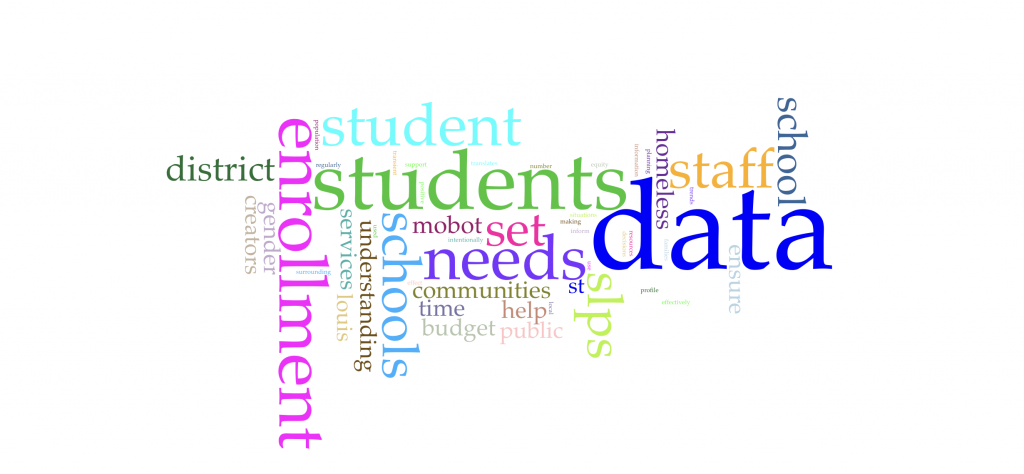St. Louis Public Schools Data Review
Data set profile:
- Who is credited as the creator and/or contributors of this data set? Who are they? St. Louis Public Schools-Office of Institutional Advancement.
- What are the sources of their data? Records of staff/students (birth certificates mentioned)
- Why did they create or compile it? Race/ethnicity is represented as a pie chart, other data is a typed percentage.
- How has it been used? On the St. Louis Public School webpage, looking at the district profile, the “about us” tab has the data on the bottom of the page.
Data set evaluation:
- Take a look at the data itself. How have they structured it? What fields have they chosen? What effect might that have on how it can be used?
The overview of SLPS is separated in the following categories: District School count, Student enrollment, Gender, Enrollment over time, Students in transmon (homeless), staff, SLPS regularly translates, and approved budget.
- Read the creators’ description of the data set. Have they described the choices they made in cleaning the data, and if so, how? What effect might those choices have on the data?
SLPS has text above the data that is very positive. They highlight the high number of enrolled students and the growth over time.
- Consider the creators’ identities and goals in creating the data set. How might those things have shaped the data, either intentionally or inadvertently?
The creators of the dataset show they are committed to equity and inclusion, they have intentionally included variables such as gender, students in transient situations (homeless), and language translation services to ensure that the needs of all students, including those from underrepresented communities are addressed.
- What would you use this data for?
- Analyzing student enrollment and district school count can help in resource allocation. Understanding the number of students in each school and their needs can aid in distributing funds, staff, and other resources effectively.
- Examining enrollment trends over time can provide insights into population shifts, demographics, and the effectiveness of education policies. This information can inform future planning and policy-making decisions.
- Gender distribution within schools can be assessed to ensure equity and diversity. Additionally, tracking students in transient situations (homeless) can help identify areas where additional support services may be needed.
- Understanding the student-to-staff ratio can assist in making staffing decisions, such as hiring teachers, counselors, or support staff, based on the needs of the student population.
- Monitoring whether the district regularly translates materials into different languages can ensure access to information for students and families with diverse backgrounds.
- Analyzing the approved budget against various factors such as enrollment, staff size, and specific student needs can aid in budget planning and management, ensuring that resources are allocated efficiently and effectively.
- Identifying trends in enrollment, such as declining enrollment in certain schools or demographic groups, can prompt intervention strategies to address underlying issues and improve student outcomes.
- How might this data help you understand the complex dynamics of MOBOT and its surrounding communities?
MOBOT can use SLPS data to inform collaborative partnerships and outreach initiatives with local schools and educational organizations. By understanding the needs and challenges facing SLPS students and families, MOBOT can tailor its programs and services to better meet the needs of the surrounding communities and foster positive relationships with local stakeholders.
